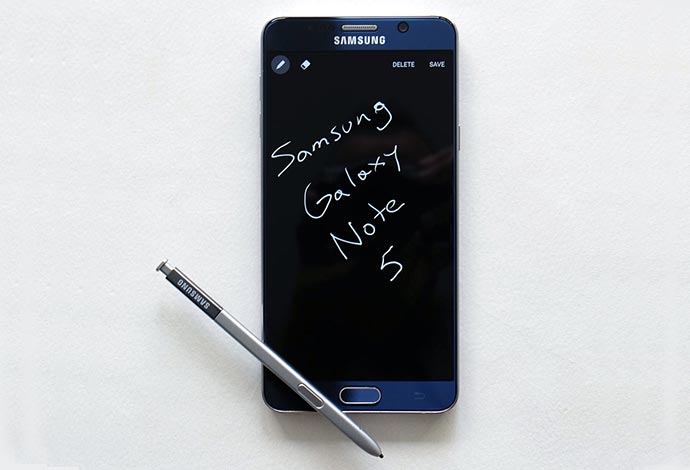
|
Display: 5.7-inch 2560 x 1440 Super AMOLED dual-curved display with 518 pixels per inch OS: Android 5.1.1 Lollipop Processor: 2.1GHz + 1.5GHz Exynos 7420 octa-core processor Memory: 4GB RAM, 32GB (no expandable storage) Camera: 16-megapixel rear camera with optical image stabilization, 5-megapixel front-facing Video: Up to 4K Ultra HD video recording Battery: 3000mAh (non-removable) Connections: LTE, Wi-Fi (Wireless-AC), Bluetooth 4.0, NFC, A-GPS, Wireless Charging Dimensions: 6.08 x 2.98 x 0.3 inches Weight: 171 grams Comes in Black Sapphire |
Samsung helped start the current trend of bigger phones with bigger screens when it first unveiled the original Galaxy Note back in 2012. The screen has since grown, while the phone’s body has trimmed down, turning what was once one of the largest handsets into one that fits in with much of the pack. The Samsung Galaxy Note 5 isn’t a big leap from its predecessor, but it does have some new features that make better use of its constituent parts.
Design
Not surprisingly, it’s the Note 5’s 5.7-inch Super AMOLED display that stands out, even though it’s the same size and resolution as last year’s model. It does, however, lie on a panel that is a fair bit slimmer and slightly thinner, making the device a little more wieldy than in the past. Except this does come at a cost that may polarize users in the same way the Galaxy S6 and S6 Edge did. There is no expandable memory beyond the 32GB or 64GB of internal storage.
The battery is also non-removable, putting the Note line now firmly in the same camp as the Galaxy S series. With glass now covering the back, and wireless charging now included underneath, the synergy between the Galaxy S and Note lines is as close as it’s ever been. Indeed, the design and construction of the Note 5 is very similar to the Galaxy S6, with curved corners, metal edges and slightly (less) protruding lens in the back.
This makes the phone elegant in a way that the Note has never truly been before. Everything on it not only looks classy, it feels like it, too. Granted, the glass on the back is a fingerprint magnet requiring regular cleaning, but it’s hard to argue with the quality here.
Under the hood, not a whole lot has changed. This is the first time a Note phone is running on Samsung’s own Exynos octa-core processor, which again, is the exact same one the Galaxy S6, S6 Edge and S6 Edge+ are using. RAM gets a boost to 4GB, though I’m not so sure the extra gigabyte translates to a tangible difference in performance for most users.
The same fingerprint reader used in the previous Galaxy S phones was used here as well. It’s a solid feature and works exactly the same way.
As before, the S Pen comes out of a holster from the bottom. It’s spring-loaded this time, where pushing it once releases the handle to pull it out.
The S Pen
It’s a good segue because Samsung makes it fairly clear (at least to me) that it wants users taking the pen a little more seriously. To help the cause, more convenience and customization has been thrown in to help the cause. Removing the pen from its holster while the phone was asleep automatically brought up a plain black canvas that I could write on. Anything I wrote could then be saved as a memo that I could use or edit afterward. I personally didn’t need to use it often, but I could see the benefit for someone who would. By not having to launch an app, jotting down a quick or simple note was effortless.
Air Command, the contextual menu that overlays onto the screen when clicking the pen’s action button, is now customizable. I was able to add up to three apps of my choice (the other three are always there), which could be anything. Naturally, I narrowed down my choices to those that could be useful to write on, like Google Maps and Gallery, for instance.

By default, Air Command pops up when sliding the pen out while the screen is unlocked, though this could be turned off in the settings. It’s always been a good way to shortcut to relevant apps for the pen, now made more interesting by the added customization. I’m not sure this is enough to push users to adopt the pen more regularly, but it’s hard to argue against its merits, either way. It’s neat that Screen Write, one of the default Note apps, allows for screenshots of a full web page or longer form content. Not something I would need often, but useful for those times I do.
The pen did feel a little more precise for me—meaning it was easier to write more legibly instead of the chicken scratch I’ve managed in previous Note devices. In my job, taking notes is a regular occurrence, and this may have been the first time I felt like I could get a little closer to the accuracy of pen on paper. It’s not there yet, but it’s certainly better than it was.
Performance and software
Where the Note 4 had an impact on the Galaxy S6, the reverse is true with the Note 5. Much of what I experienced on this phone was familiar because of the Galaxy S6 and S6 Edge, where a reduced TouchWiz presence gave way to a more relaxed version of Android with Samsung’s flavouring.
Samsung has learned over the years that less is more, and its software extras are available as downloads via the Galaxy Apps app. Otherwise, there is little to differentiate the interface and software here from what the Galaxy S6 models have to offer this year. The line is blurring between them.
The fact that everything runs smoothly and the Note 5’s hardware is capable of robust performance shouldn’t come as a surprise. There is a lot of power to work with, and it shows with the fluidity and consistency in simply navigating through menus and apps. There just isn’t anything vastly different from before—at least as it relates to the Galaxy S6. Note 4 users will notice incremental upgrades, whereas Galaxy S6 users will notice much of the same.

Camera
Again, the Note 5’s camera is a virtual carbon copy of the Galaxy S6. It uses the same wider f/1.9 aperture lens, bringing in more light to benefit low-light and night shots. The 16-megapixel rear and 5-megapixel front-facing cameras aren’t exactly the same in spec, but differ little in output and performance.
Even double-pressing the home button immediately launches the camera—yet another feature migrated from the S6. The camera interface is essentially the same as well, with Auto HDR now a staple within it. Tap to focus and exposure control are built-in to the Auto mode, allowing users to adjust brightness and darkness before snapping. The manual Pro mode includes the option to shoot in RAW (it saves a JPEG, too) for those who want greater control over editing.
I found image quality to be no different from what I saw with the two Galaxy S6 phones. That’s a good thing, given the rich colours and decent low-light results. Unlike previous Notes and their so-so cameras, the Note 5 is easily the best the line has ever had. It’s just worth noting that Samsung already deployed it in the Galaxy S6 models.
One interesting addition on the video side is the live broadcasting feature that records directly to YouTube. There is a 30-second delay between starting the video and the footage appearing on the popular streaming platform, and is only currently available on the Note 5 and Galaxy S6 Edge+. With Periscope and Meerkat already popular with users, it’s hard to say what makes this a standout. Maybe time will tell.
 Battery life
Battery life
The absence of a removable battery may vex some consumers interested in the flexibility of swapping them, but I personally don’t mind the enclosed design. Much like the Galaxy S6 models, the processor is supposed to offer the kind of increased efficiency that takes less out of the battery.
To help persuade people, the included charger is of the faster variety, able to get the phone from empty to full in only 90 minutes. A 10-minute fast charge can offer four hours of usage.
Wireless charging has also seen improvement from the Galaxy S6 models. Samsung is also the only vendor that is currently supporting the two prime wireless charging standards — Qi and PMA. And it now takes only two hours to go from empty to full when laid down on a charging mat. That’s impressive compared to the 360 minutes of the S6 models.
Battery life is pretty subjective because it depends on usage patterns and habits, but suffice it to say, the Note 5 held out quite well for me, and felt like a notable improvement from the Note 4, which incidentally had a slightly larger battery inside.
Final Thoughts
The interesting thing about the Note 5 is that it no longer stands alone—even within Samsung’s family of devices—as the main big screen handset. The Galaxy S6 Edge+ is the same phone inside and out, save for the curved edges and lack of the S Pen stylus. Otherwise, the changes here are incremental, and not a huge step up from the Note 4. If you value the removable battery and expandable memory card storage, you may want to hold off on this one.
But if you’re using the Note 3 or another big phone and feel you need a change, this is clearly one of the best available now. The Note line has always been designed to be elite, though the larger screen usually trumped the S Pen as the core feature. That’s now been turned upside down, given that the S6 Edge+ has the same screen size. Any way you look at it, it’s a solid phone with great performance.
The Samsung Galaxy Note 5 is available now.




this is the nice article about Samsung note 5..Keep sharing.
I have a similar article “https://amazonshope1.blogspot.com/2017/12/review-for-mi-max-2018-mi-max-2018.html”
Just as a caution the s.pen can be put in backwards and break your phone
Comments are closed.